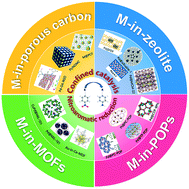Porous materials confining noble metals for the catalytic reduction of nitroaromatics: controllable synthesis and enhanced mechanism
Abstract
In the field of nanocatalysis, noble metal nanoparticles (NPs) have aroused tremendous attention owing to their superb catalytic efficiency, especially in the catalytic reduction of nitroaromatics. To overcome the disadvantages of noble metal-based catalysts, such as the leaching or aggregation of metal NPs, a wide variety of porous materials have been explored as confining units to improve their activity. By confining noble metal NPs in porous materials, unprecedentedly high catalytic activity, unique size selectivity, and enhanced recyclability can be realized in the catalytic reduction of hazardous nitroaromatic compounds. In this review, the advanced progress in strategies for the controlled synthesis of porous materials confining noble metals is elucidated. Then, the confinement effect mediated by the encapsulation of noble metals in the cavities of porous carbon, zeolites, metal–organic frameworks (MOFs), and porous organic polymers (POPs) is emphatically outlined. Furthermore, the size effect from NPs to sub-nanoscale species (single atom and metal clusters) in the confining environment is elaborated. We hope that this work will provide a fundamental understanding about the superiority of encapsulated catalysts over conventional supported catalysts and pave the way for the rational design of multifunctional porous materials confining noble metals for the more efficient reduction of nitroaromatic derivatives.



 Please wait while we load your content...
Please wait while we load your content...